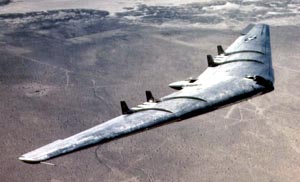Northrop YB-49
|
|
The Northrop YB-49 was a prototype jet-powered flying wing heavy bomber aircraft developed for the United States Air Force shortly after World War II. It was a development of the piston-engined B-35, and the two YB-49s actually built were both converted YB-35 test aircraft. The aircraft was never to enter production, however, being passed over in favour of the more conventional Convair B-36 in service. However, the design provided inspiration for Northrop's later B-2 Spirit bomber.
With the B-35 programme seriously behind schedule by 1944, and the end of the piston-engined warplane in sight, the production contract for the type was cancelled in May. Nevertheless, the design was still sufficiently interesting to the Air Force that work on the pre-production aircraft was ordered to continue for testing purposes. Amongst the aircraft to be completed were two that the Air Force required to be fitted with jet propulsion.
The first aircraft flew on October 1 1947 and immediately proved more promising than its piston-engined counterpart. The YB-49 set both an unofficial endurance record of staying continually above 40,000 ft (12,200 m) for six hours, and a trans-continental speed record, flying from Muroc Air Force Base in California to Andrews Air Force Base in Washington, DC in 4 hours 20 minutes. The programme nevertheless experienced a number of serious setbacks, not least of which was a disastrous crash of one of the prototypes, killing its pilot, Capt Glen Edwards (after whom Edwards Air Force Base is named) and all crew. The cause was never fully explained, but appears to have been a serious structural failure.
In September 1948, the Air Force ordered the type into production as the RB-49A reconnaissance aircraft, with Convair to undertake the mass-production. By January, however, this order was cancelled, due in part to a particularly damning report delivered by Air Force test pilot Maj Robert Cardenas in November which painted the aircraft as seriously unstable.
Aerodynamics experts have recently proposed the theory that the instability of the YB-49 was due to the fact that it was adapted from the YB-35 without taking into account the need to redesign the wing completely after the removal of the propellers. They note that the propeller equipped YB-35 did not have instability problems, since the spinning propellers acted as discs in the airflow and gave an important stabilizing surface, which was absent with the jet engines.
Testing of the one remaining YB-35 prototype still continued through most of 1949, with the aircraft demonstrating many problems as a bombing platform and also suffering a major engine-bay fire. On March 15 1950, the programme was cancelled completely, and co-incidentally, the prototype suffered an accident while taxiing and was totally destroyed in the fire that ensued.
There is a long-standing conspiracy theory about the cancellation of the B-35 and B-49 programme. Specifically, it is alleged that Air Force Secretary Stuart Symington attempted to coerce Jack Northrop to merge his company with the government-controlled Convair concern. It is further suggested that when Northrop refused, Symington arranged the cancellation of the aircraft. This interpretation was further fuelled when Jack Northrop made these accusations directly in a television interview recorded in 1979, not long before his death in 1981. Northrop also claimed to have covered for Symington, lying under oath during a congressional hearing into Convair unfair advantage in 1949 because he was fearful of reprisals had he told the truth. Symington consistently claimed that there was nothing in these allegations. Critics of the conspiracy theory point out that not only did the YB-49 have a series of well-documented major problems, but was incapable of carrying the nuclear weapons that the B-36 could. They also point out that at the same time that the B-49 was being cancelled, Northrop successfully tendered for a production contract for the F-89 Scorpion interceptor.
Specifications (YB-49)
General characteristics
- Crew: 7
- Length: 53 ft 1 in (16.20 m)
- Wingspan: 172 ft 0 in (52.40 m)
- Height: 20 ft 3 in (6.2 m)
- Wing area: 4,000 ft² (371.6 m²)
- Empty: 88,442 lb (40,116 kg)
- Loaded: 133,559 lb (60,581 kg)
- Maximum takeoff: 193,938 lb (87,969 kg)
- Powerplant: 8× Allison J35-A-15 turbojets; 3,800 lbf (17 kN) thrust
Performance
- Maximum speed: 493 mph (789 km/h)
- Combat range: 1,615 miles (2,584 km)
- Ferry range: 3,578 miles (5,720 km)
- Service ceiling: 45,700 ft (13,900 m)
- Rate of climb: 3,758 ft/min (1,145 m/min)
- Wing loading: 33 lb/ft² (163 kg/m²)
- Thrust/weight ratio: 0.23 lbf/lb (2.2 N/kg)
Armament
- 4 × .50 caliber (12.7 mm) machine guns
- 32,000 lb (14,500 kg) of bombs
External links
- USAF Museum: XB-49 (http://www.wpafb.af.mil/museum/research/bombers/b4/b4-36.htm), YB-49 (http://www.wpafb.af.mil/museum/research/bombers/b4/b4-37.htm), and YRB-49A (http://www.wpafb.af.mil/museum/research/bombers/b4/b4-38.htm).
- The Crash of the YB-49 - Flying Wing (http://www.check-six.com/Crash_Sites/YB-49_crash_site.htm)
Related content
Related development: Northrop N1M - Northrop N9M - Northrop YB-35
Comparable aircraft:
Designation sequence: XB-46 - B-47 - XB-48 - YB-49 - B-50 - XB-51 - B-52
Related lists: List of military aircraft of the United States - List of bomber aircraft - List of flying wings
|
Lists of Aircraft | Aircraft manufacturers | Aircraft engines | Aircraft engine manufacturers Airports | Airlines | Air forces | Aircraft weapons | Missiles | Timeline of aviation |

